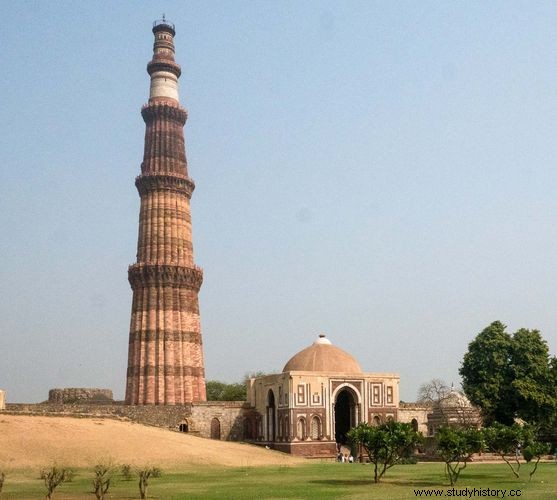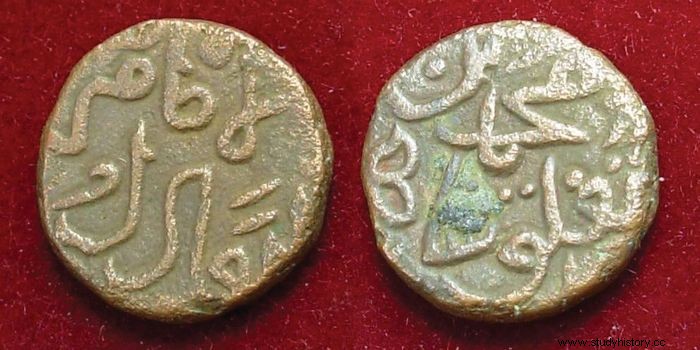Delhi Sultanate , main Muslim sultanate in North India from the 13th to the 16th centuries. It owed its foundation mainly to the campaigns of Muʿizz al-Dīn Muḥammad ibn Sām (Muḥammad of Ghūr; brother of Sultan Ghiyāth al-Dīn of Ghūr) and his lieutenant Quṭb al-Dīn Aibak between 1175 and 1206 and in particular the victories at the battles of Taraōrī in 1192 and Chandawar in 1194.

 Read more about this topic India:The Delhi Sultanate The decline of the Ghaznavids after 1100 was marked by the sacking of Ghazna by the rival Shansabānīs of Ghūr in 1150–51 strengthened. The Ghūrids, ...
Read more about this topic India:The Delhi Sultanate The decline of the Ghaznavids after 1100 was marked by the sacking of Ghazna by the rival Shansabānīs of Ghūr in 1150–51 strengthened. The Ghūrids, ... The Ghūrid Soldiers of Fortune in India only severed their political connection with Ghūr (now Ghowr, in present-day Afghanistan) in the Sultan Iltutmish (r. 1211–36) had its permanent capital at Delhi conquers , repelled rival attempts to take over the Ghūrid conquests in India and his forces out of contact with the Mongolian Armies retreated in the 1220s Afghanistan . Iltutmish also gained firm control over the major urban strategic centers North Indian plain from which he refractory Rajput- bosses in check . After Iltutmish's death, a decade of factional infighting was followed by almost 40 years of stability under Ghiyāth al-Dīn Balban, Sultan from 1266 to 1287. During this period, Delhi remained on the defensive against the Mongols and took only precautionary measures against the Rajputs.
Among the Sultans of The Khaljī Dynasty (1290–1320), the Delhi Sultanate became an imperial power. ʿAlāʾ al-Dīn (r. 1296–1316) conquered Gujarat (ca. 1297) and the most important fortified places in Rajasthan (1301–12) and reduced the major Hindu kingdoms of southern India (1307–12) to vassals. His forces also defeated heavy Mongol attacks by the Chagatais of Transoxania (1297–1306).
Muḥammad ibn Tughluq (r. 1325–51) attempted to establish a Muslim military, administrative, and cultural elite in the Deccan with a second capital in Daulatabad to build but the Deccan Muslim Aristocracy threw off the suzerainty of Delhi and founded (1347) the Bahmanī Sultanate . Muḥammad's successor, Fīrūz Shah Tughluq (r. 1351–88), made no attempt to reconquer the Deccan.

The power of the Delhi Sultanate in northern India was reduced by the invasion (1398–99) of the Turkish conqueror Timur (Tamerlane) who sacked Delhi itself. Under the Sayyid Dynasty (ca. 1414–51) the sultanate was reduced to a land power, constantly quarreling with other small Muslim and Hindu equated with principalities. Under the Lodī (Afghan) Dynasty (1451–1526), however, the Delhi Sultanate partially recovered from its with its large-scale immigration from Afghanistan Hegemony until the mogul leader Bābur destroyed it first Battle of Panipat on April 21, 1526. After 15 years of Mughal rule, the Afghan Shēr Shah by Sūr restored the sultanate in Delhi, which passed again to Bābur's son and successor in 1555 Humāyūn fell who died January 1556 At the Battle of Panipat (November 5, 1556) defeated Humāyūn's son Akbar the Hindu general Hemu finally, and the sultanate emerged in the Mogul empire on .
The Sultanate of Delhi made no break with the political traditions of the later Hindu period - namely, that rulers took precedence over Sovereignty searched . It never reduced the Hindu chiefs to unarmed impotence or a exclusive claim Loyalty established . The Sultan was heterogeneous Served by elite Turks, Afghans, Khaljis and Hindu converts; He readily accepted Hindu officials and Hindu vassals. Long threatened by the Mongol invasion from the northwest and hampered by indifferent communications, the sultans of Delhi perforce allowed their local governors and officials great discretion.
